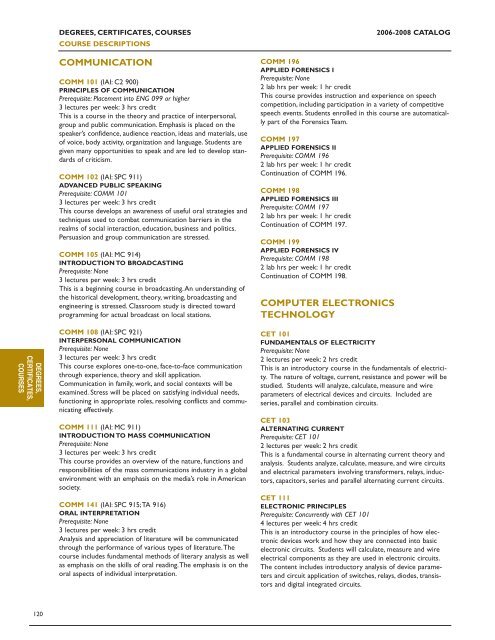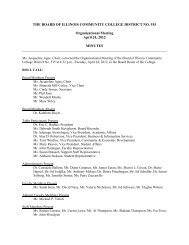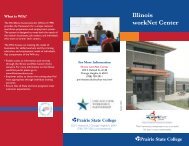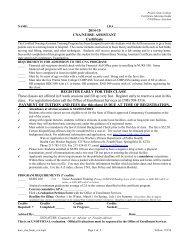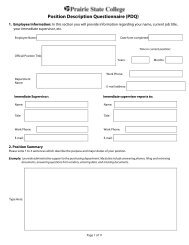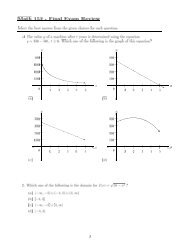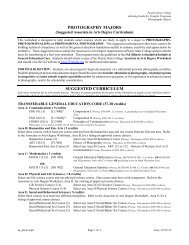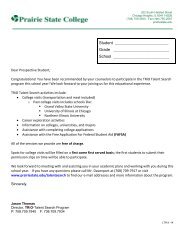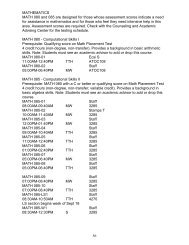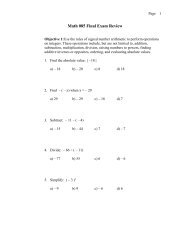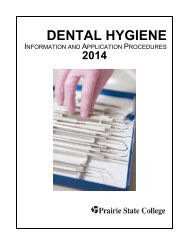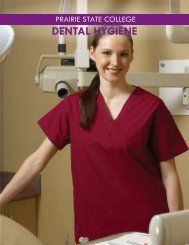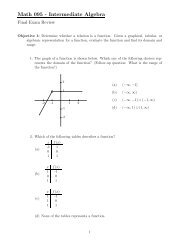DEGREES,CERTIFICATES,COURSESDEGREES, CERTIFICATES, COURSESCOURSE DESCRIPTIONSCOMMUNICATIONCOMM 101 (IAI: C2 900)PRINCIPLES OF COMMUNICATIONPrerequisite: Placement into ENG 099 or higher3 lectures per week: 3 hrs creditThis is a course in the theory and practice of interpersonal,group and public communication. Emphasis is placed on thespeaker’s confidence, audience reaction, ideas and materials, useof voice, body activity, organization and language. Students aregiven many opportunities to speak and are led to develop standardsof criticism.COMM 102 (IAI: SPC 911)ADVANCED PUBLIC SPEAKINGPrerequisite: COMM 1013 lectures per week: 3 hrs creditThis course develops an awareness of useful oral strategies andtechniques used to combat communication barriers in therealms of social interaction, education, business and politics.Persuasion and group communication are stressed.COMM 105 (IAI: MC 914)INTRODUCTION TO BROADCASTINGPrerequisite: None3 lectures per week: 3 hrs creditThis is a beginning course in broadcasting.An understanding ofthe historical development, theory, writing, broadcasting andengineering is stressed. Classroom study is directed towardprogramming for actual broadcast on local stations.COMM 108 (IAI: SPC 921)INTERPERSONAL COMMUNICATIONPrerequisite: None3 lectures per week: 3 hrs creditThis course explores one-to-one, face-to-face communicationthrough experience, theory and skill application.Communication in family, work, and social contexts will beexamined. Stress will be placed on satisfying individual needs,functioning in appropriate roles, resolving conflicts and communicatingeffectively.COMM 111 (IAI: MC 911)INTRODUCTION TO MASS COMMUNICATIONPrerequisite: None3 lectures per week: 3 hrs creditThis course provides an overview of the nature, functions andresponsibilities of the mass communications industry in a globalenvironment with an emphasis on the media’s role in Americansociety.COMM 141 (IAI: SPC 915;TA 916)ORAL INTERPRETATIONPrerequisite: None3 lectures per week: 3 hrs creditAnalysis and appreciation of literature will be communicatedthrough the performance of various types of literature.Thecourse includes fundamental methods of literary analysis as wellas emphasis on the skills of oral reading.The emphasis is on theoral aspects of individual interpretation.COMM 196APPLIED FORENSICS IPrerequisite: None2 lab hrs per week: 1 hr creditThis course provides instruction and experience on speechcompetition, including participation in a variety of competitivespeech events. Students enrolled in this course are automaticallypart of the Forensics Team.COMM 197APPLIED FORENSICS IIPrerequisite: COMM 1962 lab hrs per week: 1 hr creditContinuation of COMM 196.COMM 198APPLIED FORENSICS IIIPrerequisite: COMM 1972 lab hrs per week: 1 hr creditContinuation of COMM 197.COMM 199APPLIED FORENSICS IVPrerequisite: COMM 1982 lab hrs per week: 1 hr creditContinuation of COMM 198.COMPUTER ELECTRONICSTECHNOLOGY2006-2008 CATALOGCET 101FUNDAMENTALS OF ELECTRICITYPrerequisite: None2 lectures per week: 2 hrs creditThis is an introductory course in the fundamentals of electricity.The nature of voltage, current, resistance and power will bestudied. Students will analyze, calculate, measure and wireparameters of electrical devices and circuits. Included areseries, parallel and combination circuits.CET 103ALTERNATING CURRENTPrerequisite: CET 1012 lectures per week: 2 hrs creditThis is a fundamental course in alternating current theory andanalysis. Students analyze, calculate, measure, and wire circuitsand electrical parameters involving transformers, relays, inductors,capacitors, series and parallel alternating current circuits.CET 111ELECTRONIC PRINCIPLESPrerequisite: Concurrently with CET 1014 lectures per week: 4 hrs creditThis is an introductory course in the principles of how electronicdevices work and how they are connected into basicelectronic circuits. Students will calculate, measure and wireelectrical components as they are used in electronic circuits.The content includes introductory analysis of device parametersand circuit application of switches, relays, diodes, transistorsand digital integrated circuits.120
2006-2008 CATALOGCET 114DIGITAL FUNDAMENTALSPrerequisite: None4 lectures per week: 4 hrs creditThis is an introductory course in digital systems. Numberingsystems and codes are introduced along with logic representationand combination digital logic circuits. Logic gates, logicfamilies and interfacing of components are studied. Related circuitrywill be wired and analyzed.CET 203INSTRUMENTATION FUNDAMENTALSPrerequisite: CET 1014 lectures per week: 4 hrs creditThis course is a study of electronic instrumentation with applicationsto the control of industrial processes.Topics includemeasuring instruments, an introduction to process control,transducers, controller principles and control elements.CET 211COMMUNICATION ELECTRONICSPrerequisite: CET 1034 lectures per week: 4 hrs creditThis course is a continuation of electronic studies extendinginto communications applications.Topics include feedback, oscillators,modulation, demodulation, R.F. amplification, wave propagation,wave transmission and wave radiation.Analysis techniqueswill be extended from the time domain to frequency domain.CET 220PROGRAMMABLE LOGIC CONTROLLERSPrerequisite: None4 lectures per week: 4 hrs creditStudents will program, download and wire input and outputdevices using Allen-Bradley software for the SLC-500 andMicro-Logic 1000 programmable logic controllers.COMPUTER AND INFORMATIONSYSTEMS(see Information Technology)CRIMINAL JUSTICE SERVICESCJ 101 (IAI: CRJ 901)INTRODUCTION TO CRIMINAL JUSTICEPrerequisite: None3 lectures per week: 3 hrs creditThis is a survey and analysis of the criminal justice system,including a historical, developmental and philosophical overviewof development of law as a means of social control. Specialemphasis is placed on the system’s primary components andthe relationship of these components in the administration ofcriminal justice in America.CJ 102 (IAI: CRJ 912)INTRODUCTION TO CRIMINOLOGYPrerequisite: None3 lectures per week: 3 hrs creditThis course is an introduction to the multidisciplinary study andanalysis of the nature, causes and control of crime in America.The measurement of crime and the interactive roles of the system,victim, offender and society are also covered.DEGREES, CERTIFICATES, COURSESCOURSE DESCRIPTIONSCJ 103LAW ENFORCEMENT ORGANIZATION ANDADMINISTRATIONPrerequisite: None3 lectures per week: 3 hrs creditThis course focuses on the principles of organization and managementas applied to law enforcement agencies.Topics coveredinclude concepts of organization behavior, formulation of policyand procedure and coordination of operational units.CJ 106 (IAI: CRJ 911)INTRODUCTION TO CORRECTIONSPrerequisite: None3 lectures per week: 3 hrs creditAn overview and analysis of the American correction system ispresented, including the history, evolution and philosophy of punishmentand treatment.The operation and administration ofcriminal justice in both institutional and non-institutional settingsis covered. Current issues in correctional law are also presented.CJ 108PROBATION, PAROLE AND COMMUNITY-BASEDCORRECTIONPrerequisite: CJ 1063 lectures per week: 3 hrs creditThe organization and operation of probation and parolesystems, including history, laws, ideologies and problems arestudied. Issues of supervision and evaluation of communitybasedcorrectional institutions such as halfway houses andwork-release programs are investigated.CJ 110COMMUNITY-BASED POLICINGPrerequisite: CJ 1013 lectures per week: 3 hrs creditThe philosophical and practical applications of communitybasedpolicing are presented.CJ 120INTRODUCTION TO HOMELAND SECURITYPrerequisite: None3 lectures per week: 3 hrs creditThis course examines the programs and activities that havebeen implemented to improve the safety of our country.Special emphasis is placed on the threat of terrorism andstrategies to address that threat.CJ 201 (IAI: CRJ 913)INTRODUCTION TO CRIMINAL LAWPrerequisite: None3 lectures per week: 3 hrs creditThis course examines and analyzes the structure and functionsof substantive criminal law.The principles of criminal law arepresented, including the acts, mental state and attendant circumstancesthat are necessary elements of the crime.CJ 202CIVIL AND CRIMINAL LAWS/PROCEDURESPrerequisite: None3 lectures per week: 3 hrs creditThis course examines legal concepts and criminal procedures inthe areas of arrest, force, search and seizure, interrogation, andobtainment of physical evidence.Also included are studies ontrials, indictments, bail, grand and petit juries, and the rules ofevidence in the <strong>State</strong> of Illinois.DEGREES,CERTIFICATES,COURSES121
- Page 1 and 2:
A comprehensive community college20
- Page 3 and 4:
2006-2008 CATALOGIllinois Community
- Page 5 and 6:
2006-2008 CATALOGCONTENTSOVERVIEW:
- Page 7 and 8:
2006-2008 CATALOGOVERVIEWGETTING AC
- Page 9 and 10:
2006-2008 CATALOGOVERVIEWASSOCIATE
- Page 11 and 12:
2006-2008 CATALOGOVERVIEWIllinois E
- Page 13 and 14:
2006-2008 CATALOGENROLLMENTSTARTING
- Page 15 and 16:
2006-2008 CATALOGENROLLMENT7. Pay t
- Page 17 and 18:
2006-2008 CATALOGENROLLMENTSPECIAL
- Page 19 and 20:
2006-2008 CATALOGPOLICIES & GUIDELI
- Page 21 and 22:
2006-2008 CATALOGPOLICIES & GUIDELI
- Page 23 and 24:
2006-2008 CATALOGPOLICIES & GUIDELI
- Page 25 and 26:
2006-2008 CATALOGPOLICIES & GUIDELI
- Page 27 and 28:
2006-2008 CATALOGPOLICIES & GUIDELI
- Page 29 and 30:
2006-2008 CATALOGSTUDENT SERVICESFI
- Page 31 and 32:
2006-2008 CATALOGSTUDENT SERVICESFI
- Page 33 and 34:
2006-2008 CATALOGSTUDENT SERVICESOT
- Page 35 and 36:
2006-2008 CATALOGSTUDENT LIFEEXPERI
- Page 37 and 38:
2006-2008 CATALOGSTUDENT LIFENORTH
- Page 39 and 40:
2006-2008 CATALOGSTUDENT LIFECULTUR
- Page 41 and 42:
2006-2008 CATALOGDEGREES, CERTIFICA
- Page 43 and 44:
2006-2008 CATALOGILLINOIS ARTICULAT
- Page 45 and 46:
2006-2008 CATALOGFine Arts CoursesA
- Page 47 and 48:
2006-2008 CATALOGDEGREES, CERTIFICA
- Page 49 and 50:
2006-2008 CATALOGDEGREES, CERTIFICA
- Page 51 and 52:
2006-2008 CATALOGBUSINESSA.A. Degre
- Page 53 and 54:
2006-2008 CATALOGCOMPUTER SCIENCEA.
- Page 55 and 56:
2006-2008 CATALOGEARTH SCIENCE/GEOL
- Page 57 and 58:
2006-2008 CATALOGDEGREES, CERTIFICA
- Page 59 and 60:
2006-2008 CATALOGGENERAL MATH/SCIEN
- Page 61 and 62:
2006-2008 CATALOGLIBERAL ARTSA.A. D
- Page 63 and 64:
2006-2008 CATALOGPRE-MEDICINEA.S. D
- Page 65 and 66:
2006-2008 CATALOGPRE-OCCUPATIONAL T
- Page 67 and 68:
2006-2008 CATALOGPRE-PHYSICAL THERA
- Page 69 and 70:
2006-2008 CATALOGSOCIAL WORKA.A. De
- Page 71 and 72: 2006-2008 CATALOGDEGREES, CERTIFICA
- Page 73 and 74: 2006-2008 CATALOGCAREER PROGRAMSThe
- Page 75 and 76: 2006-2008 CATALOGAUTOMOTIVE ALIGNME
- Page 77 and 78: 2006-2008 CATALOGDEGREES, CERTIFICA
- Page 79 and 80: 2006-2008 CATALOGDEGREES, CERTIFICA
- Page 81 and 82: 2006-2008 CATALOGDEGREES, CERTIFICA
- Page 83 and 84: 2006-2008 CATALOGDEGREES, CERTIFICA
- Page 85 and 86: 2006-2008 CATALOGDEGREES, CERTIFICA
- Page 87 and 88: 2006-2008 CATALOGDEGREES, CERTIFICA
- Page 89 and 90: 2006-2008 CATALOGDEGREES, CERTIFICA
- Page 91 and 92: 2006-2008 CATALOGDEGREES, CERTIFICA
- Page 93 and 94: 2006-2008 CATALOGNURSINGContinuedNU
- Page 95 and 96: 2006-2008 CATALOGINDUSTRIAL ELECTRI
- Page 97 and 98: 2006-2008 CATALOGMANUFACTURING TECH
- Page 99 and 100: 2006-2008 CATALOGINFORMATION TECHNO
- Page 101 and 102: 2006-2008 CATALOGCOMPUTER REPAIR SP
- Page 103 and 104: 2006-2008 CATALOGSPREADSHEET - PROF
- Page 105 and 106: 2006-2008 CATALOGDEGREES, CERTIFICA
- Page 107 and 108: 2006-2008 CATALOGDEGREES, CERTIFICA
- Page 109 and 110: 2006-2008 CATALOGILLINOIS ARTICULAT
- Page 111 and 112: 2006-2008 CATALOGART 126 (IAI: F2 9
- Page 113 and 114: 2006-2008 CATALOGAUTO 214COLLISION
- Page 115 and 116: 2006-2008 CATALOGBIOL 225FUNCTIONAL
- Page 117 and 118: 2006-2008 CATALOGBUS 169MATERIALS H
- Page 119 and 120: 2006-2008 CATALOGBUS 270INTERNATION
- Page 121: 2006-2008 CATALOGCHEM 203 (IAI: BIO
- Page 125 and 126: 2006-2008 CATALOGDH 108CLINICAL DEN
- Page 127 and 128: 2006-2008 CATALOGEARLY CHILDHOOD ED
- Page 129 and 130: 2006-2008 CATALOGED 220CHILDREN’S
- Page 131 and 132: 2006-2008 CATALOGEMS 230PARAMEDICIN
- Page 133 and 134: 2006-2008 CATALOGENG 241CONTEMPORAR
- Page 135 and 136: 2006-2008 CATALOGFST 213FIRE SERVIC
- Page 137 and 138: 2006-2008 CATALOGGC 185DIGITAL SOUN
- Page 139 and 140: 2006-2008 CATALOGHIST 112 (IAI: S2
- Page 141 and 142: 2006-2008 CATALOGAPPIE 106DC MOTORS
- Page 143 and 144: 2006-2008 CATALOGAPPIE 290SPECIAL T
- Page 145 and 146: 2006-2008 CATALOGNETWORKING - ITNET
- Page 147 and 148: 2006-2008 CATALOGITPRG 141INTRODUCT
- Page 149 and 150: 2006-2008 CATALOGITWEB 220INTERNET
- Page 151 and 152: 2006-2008 CATALOGMAINTENANCE TECHNI
- Page 153 and 154: 2006-2008 CATALOGMATH 096GEOMETRYPr
- Page 155 and 156: 2006-2008 CATALOGMILLWRIGHT - APPRE
- Page 157 and 158: 2006-2008 CATALOGMUSIC 152 (IAI: MU
- Page 159 and 160: 2006-2008 CATALOGNURS 103TRANSITION
- Page 161 and 162: 2006-2008 CATALOGPHOTO 282EXPERIMEN
- Page 163 and 164: 2006-2008 CATALOGPE 163GOLFPrerequi
- Page 165 and 166: 2006-2008 CATALOGPLUMBING, PIPEFITT
- Page 167 and 168: 2006-2008 CATALOGREGISTERED NURSING
- Page 169 and 170: 2006-2008 CATALOGSRT 298SURGICAL TE
- Page 171 and 172: 2006-2008 CATALOGWELDER - APPRENTIC
- Page 173 and 174:
2006-2008 CATALOGGRADUATION & TRANS
- Page 175 and 176:
2006-2008 CATALOGGRADUATION & TRANS
- Page 177 and 178:
2006-2008 CATALOGDIRECTORYMEETING O
- Page 179 and 180:
2006-2008 CATALOGEXECUTIVE OFFICERS
- Page 181 and 182:
2006-2008 CATALOGDIRECTORYFACULTYFA
- Page 183 and 184:
2006-2008 CATALOGProfessor John Lim
- Page 185 and 186:
2006-2008 CATALOGCheryl Bland-Winbu
- Page 187 and 188:
2006-2008 CATALOGDIRECTORYSUPPORT S
- Page 189 and 190:
2006-2008 CATALOGDIRECTORYSUPPORT S
- Page 191 and 192:
2006-2008 CATALOGINDEXCollege Bowl
- Page 193 and 194:
2006-2008 CATALOGINDEXpre-Manufactu


